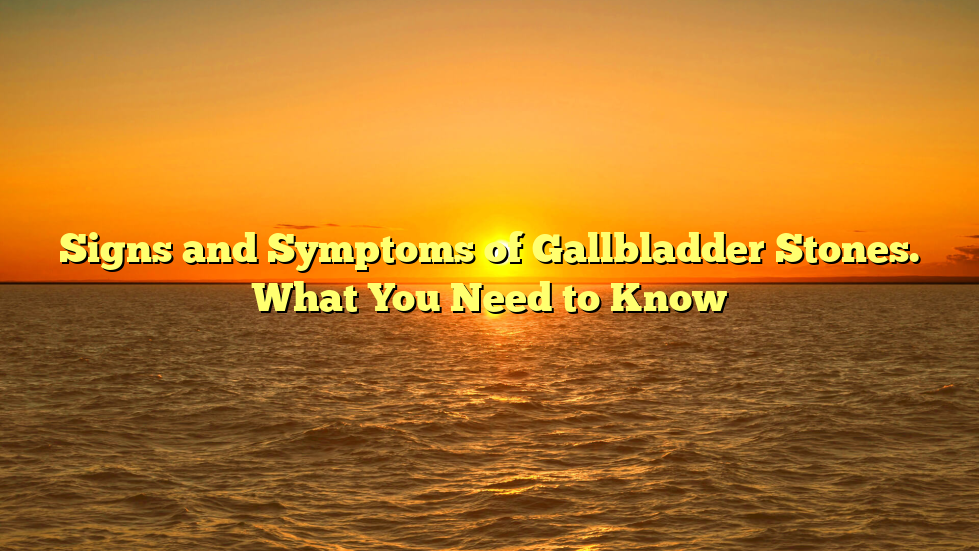Gallbladder stones, also known as gallstones, are hardened deposits that form in the gallbladder, a small organ located beneath the liver. These stones can vary in size and composition, and they can cause a range of symptoms and complications. In this blog post, we will discuss the signs and symptoms of gallbladder stones, their causes, risk factors, and available treatment options.
See More Chicken Coop Sign
1. Anatomy and Function of the Gallbladder
Before delving into the signs and symptoms of gallbladder stones, it is important to understand the role of the gallbladder in the digestive system. The gallbladder is responsible for storing bile, a substance produced by the liver that helps in the digestion of fats. When we consume fatty foods, the gallbladder contracts and releases bile into the small intestine to aid in the breakdown and absorption of fats.
2. What Causes Gallbladder Stones?
Gallbladder stones form when there is an imbalance in the components of bile, leading to the crystallization of cholesterol or bilirubin. There are several factors that can contribute to the formation of gallstones, including:
See more Product at Memorial Sign World
2.1 Cholesterol Imbalance:
The majority of gallstones are made up of cholesterol. When there is an excess of cholesterol in bile, it can solidify and form stones.
2.2 Bilirubin Imbalance:
An excessive amount of bilirubin, a yellow pigment produced during the breakdown of red blood cells, can contribute to the formation of gallstones.
See More Memorial Sign World Articles:
- Show Off Your Furry Friend with Custom Canvas Dog Prints
- Sign Closed for Memorial Day. Honoring our Fallen Heroes
2.3 Gallbladder Dysfunction:
A dysfunctional gallbladder may not empty properly or may have reduced contractions, which can lead to the accumulation of bile and the formation of gallstones.
2.4 Other Risk Factors:
Other factors that can increase the risk of developing gallstones include obesity, a sedentary lifestyle, rapid weight loss, a high-fat diet, certain medications (such as birth control pills), and certain medical conditions (such as diabetes and liver disease).
3. Signs and Symptoms of Gallbladder Stones
Gallbladder stones may not always cause noticeable symptoms. However, when they do, they can cause significant discomfort and complications. The following are common signs and symptoms associated with gallbladder stones:
3.1 Abdominal Pain:
The most common symptom of gallstones is abdominal pain, often referred to as biliary colic. This pain typically occurs in the upper right or middle abdomen and can be severe and persistent. It may radiate to the back or shoulder blades.
3.2 Nausea and Vomiting:
Gallstones can cause nausea and vomiting, particularly after a meal, due to the obstruction or inflammation of the bile ducts.
3.3 Jaundice:
If a gallstone blocks the common bile duct, it can lead to jaundice, a condition characterized by yellowing of the skin and eyes. Jaundice occurs due to the buildup of bilirubin in the body.
3.4 Indigestion and Gas:
Some individuals with gallstones may experience indigestion, bloating, and excessive gas due to impaired digestion of fats.
3.5 Changes in Stool Color:
Gallstones that obstruct the bile ducts can cause pale or clay-colored stools due to a lack of pigment from bile.
3.6 Fever and Chills:
In cases where gallstones cause inflammation or infection (cholecystitis), individuals may experience fever, chills, and an increased heart rate.
4. Diagnosing Gallbladder Stones
If you suspect you have gallbladder stones based on the aforementioned symptoms, it is crucial to consult a healthcare professional for an accurate diagnosis. The following diagnostic tests are commonly used:
4.1 Ultrasound:
An ultrasound scan is a non-invasive imaging test that uses sound waves to create images of your gallbladder. It is the most common method for diagnosing gallstones.
4.2 Blood Tests:
Blood tests may be conducted to evaluate liver function and check for signs of infection or inflammation.
4.3 HIDA Scan:
A hepatobiliary iminodiacetic acid (HIDA) scan involves injecting a radioactive tracer into your bloodstream to visualize how your gallbladder functions and if there are any obstructions.
4.4 Endoscopic Retrograde Cholangiopancreatography (ERCP):
In some cases, an ERCP may be performed to identify gallstones in the bile ducts using a combination of X-rays and an endoscope.
5. Treatment Options for Gallbladder Stones
The treatment approach for gallbladder stones depends on various factors such as symptom severity, stone size, and overall health. The following are common treatment options:
5.1 Watchful Waiting:
If you have asymptomatic gallstones or mild symptoms, your doctor may recommend monitoring your condition without intervention unless complications arise.
5.2 Medications:
Certain medications can be prescribed to dissolve cholesterol-based gallstones over time. However, this treatment option is not suitable for everyone and may take several months or years to achieve results.
5.3 Laparoscopic Cholecystectomy:
Laparoscopic cholecystectomy is a minimally invasive surgical procedure to remove the gallbladder and any associated stones. It is the most common treatment for symptomatic gallbladder stones.
5.4 Endoscopic Removal:
For individuals with smaller stones lodged in the bile ducts, endoscopic removal may be performed using an endoscope inserted through the mouth and into the digestive tract.
6. Prevention Tips for Gallbladder Stones
While gallbladder stones cannot be completely prevented, certain lifestyle modifications may reduce your risk of developing them:
6.1 Maintain a Healthy Weight:
Obesity is a significant risk factor for gallstones. Aim for a healthy weight through regular exercise and a balanced diet.
6.2 Eat a Healthy Diet:
Include plenty of fruits, vegetables, whole grains, lean proteins, and healthy fats in your diet while limiting your intake of saturated fats and cholesterol.
6.3 Stay Hydrated:
Drink an adequate amount of water each day to promote healthy digestion and prevent bile stagnation.
6.4 Avoid Rapid Weight Loss:
Rapid weight loss can increase your risk of developing gallstones. Aim for gradual weight loss through sustainable lifestyle changes.
6.5 Exercise Regularly:
Engaging in regular physical activity can help maintain healthy digestion and reduce your risk of developing gallbladder stones.
Conclusion:
Gallbladder stones can cause various symptoms ranging from abdominal pain to jaundice. If you experience any signs or symptoms associated with gallstones, it is important to consult with a healthcare professional for diagnosis and appropriate treatment options. By understanding the signs, seeking timely medical assistance, and implementing preventive measures,you can effectively manage gallbladder stone-related complications and improve your overall well-being.
#memorialsignworld, #memorialsignworldstore,#MetalMonogramSigns, #PetMemorialCanvas, #ChickenCoopSign/

